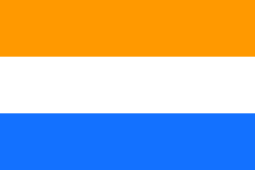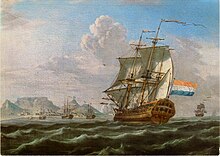 | |
| Other names | Prince's Flag (Dutch: Prinsenvlag), Oranje-blanje-bleu |
|---|---|
| Design | Three horizontal bands of orange, white and blue |
| Designed by | William the Silent |

The Prince's Flag (Dutch: Prinsenvlag) is a Dutch flag, first used in the Dutch Revolt during the late 16th century.
The Prince's Flag is based on the flag of Prince William of Orange-Nassau, hence the name. The colours are orange, white and blue. On the basis of the French names of these colours, orange-blanc-bleu, the flag is also referred to by the Dutch rhymes oranje-blanje-bleu and ranje-blanje-bleu.
This flag is controversial in the Netherlands due to its usage in the past by the pro-Nazi NSB. The flag is now mostly used in the Netherlands by far right activists and in historical re-enactment.
History
The colours orange, white and blue (Dutch: Oranje, Wit, Blauw or Oranje, Blanje, Bleu, from French Orange, Blanche, Bleu) are associated with William Prince of Orange (1533–1584). William is reported to have used these colours as early as 1577, as part of his procession entering Ghent. Jacob Duym also reports that in the siege of Leiden in 1574, the Dutch officers wore orange-white-blue brassards. From this, Rey (1837) concludes that the combination of orange-white-blue was certainly used by the Prince of Orange in the 1570s. The first reference to a naval flag in these colours dates to 1587, when the Admiralty of Zeeland ordered these flags to fly on their warships. The naval flag was used by the Watergeuzen (Gueux de mer, "Sea Beggars"), the pro-Dutch privateers during the Dutch Revolt. According to de Waard (1900), the Dutch navy between 1588 and 1630 always displayed the Prince's Flag, and after 1663 always the red-white-blue Statenvlag. The latter was introduced gradually during the 1630s to 1650s, and named "States' Flag" in 1664.
During the 17th century the Prince's Flag was hoisted on the Castle of Good Hope and saluted by incoming ships. The orange-white-blue flag formed the basis for the South African flag of 1928. It is also the basis for the flags of New York City and Albany, New York. After the republican Patriots, aided by the French, seized control over the Netherlands in 1795, the Prince's Flag was forbidden and the red-white-blue flag became the only official flag in order to dissociate from the House of Orange, to the content of the French, analogous as they were to their own tricolour, chosen just a few months earlier. In the following period of the Kingdom of Holland, there was also no place for Orange and the Bonapartist King Louis I chose red.
In 1813, when the French were expelled and the Netherlands regained its independence, the Prince of Orange returned to the country from England. The Prince's Flag saw a short revival; to demonstrate the attachment of the people to the House of Orange, both this flag and the red-white-blue flag fluttered on the roofs. In the same year, for the first time, the red-white-blue flag was flown with an orange pennant, which has remained the custom in the Netherlands. Whether the Prince's Flag or the red-white-blue flag should be the national flag was left undecided, although the Prince of Orange, later King William I, preferred the latter.
In the 1930s, the supporters of the National Socialist Movement in the Netherlands (NSB) chose the orange-white-blue and the Prince's Flag as their symbol. Queen Wilhelmina in 1937 signed a Royal Decree that the colours red, white and blue are set as the official colours of the Dutch flag.
Usage
The Prince's flag was raised from the old Matthias church tower in Warmond in 2013 as part of the celebrations of the 200th anniversary of the Kingdom of the Netherlands.
The flag is also used as a symbol of the Greater Netherlands and Dutch pan-nationalist movements. It is frequently used by extreme right-wing groups such as the Dutch People's Union (NVU) and Voorpost, as well as the (now defunct) Nationalist People's Movement (NVB).
In 2011, two members of parliament for the Party for Freedom (PVV) had the Prince's flag hanging in their offices in the parliament's building. When this was received with scrutiny, the flags were removed. Former Dutch MP Wim Kortenoeven said he was perturbed by the negative connotations the flag carries as he believes the flag was "hijacked" by the NSB. At a PVV protest on 21 September 2013 in The Hague, several attendants were carrying Prince's flags. When Geert Wilders was speaking in House of Representatives the same week, Alexander Pechtold referred to the flags as 'NSB-flags', to which Wilders called Pechtold a "sad, measly, hypocritical little man." In protest of Pechtold's remark, at least five PVV members of the House of Representatives, Martin Bosma, Reinette Klever, Machiel de Graaf, Harm Beertema and Barry Madlener wore a Prince's flag lapel pin.
Legacy
| This section may require cleanup to meet Misplaced Pages's quality standards. The specific problem is: Several of the flags displayed below are based on a combination or red-white-blue, not on the orange-white-blue of the Prince's flag. Please help improve this section if you can. (July 2024) (Learn how and when to remove this message) |
The Prince's Flag served as the basis for the flag of the Union of South Africa. This flag was adopted in 1928 and was inspired by the former Dutch flag. In the white part of the flag are the flags of (left to right) the United Kingdom, the Orange Free State and Transvaal, representing the Union's British colonial and republican predecessor states. In 1994, the flag was replaced by the post-apartheid flag of South Africa. In 2004, the Afrikaner town of Orania adopted a new flag based on the colours of the Prince's Flag. The flag is divided vertically (symbolizing a fresh beginning) with the white stripe replaced by a picture of a boy rolling up his sleeves (symbolizing going to work).
As a consequence of its beginnings as the Dutch colony of New Netherland, several places in New York State and New Jersey use variants of the Prinsenvlag as their official flags. These places include New York City, Jersey City, the Bronx, Albany, and Nassau County. The blue and orange color scheme is also used by three of New York's professional sports teams: the Knicks, Mets and Islanders.
-
 Variant on the Prince's flag
Variant on the Prince's flag
-
 Naval jack Brielse Geus
Naval jack Brielse Geus
-
 Prinsenvlag variant
Prinsenvlag variant
-
 Prinsenvlag variant
Prinsenvlag variant
-
 Statenvlag by Peter Fobs
Statenvlag by Peter Fobs
-
 Flag of the village of Hoek, Zeeland, Netherlands
Flag of the village of Hoek, Zeeland, Netherlands
-
 Flag of South Africa (1928–1994)
Flag of South Africa (1928–1994)
-
 Former flag of the President of South Africa (1984–1994)
Former flag of the President of South Africa (1984–1994)
-
 Flag of the Orange Free State
Flag of the Orange Free State
-
 Flag of Orania
Flag of Orania
-
 Flag of the former Kavangoland, South West Africa
Flag of the former Kavangoland, South West Africa
-
 Flag of New York City
Flag of New York City
-
 Flag of the Bronx, New York City
Flag of the Bronx, New York City
-
 Flag of the Borough of Manhattan, New York City
Flag of the Borough of Manhattan, New York City
-
 Flag of Albany, New York
Flag of Albany, New York
-
 Flag of Schenectady County, New York
Flag of Schenectady County, New York
-
 Flag of Ulster County, New York
Flag of Ulster County, New York
-
 Flag of Westchester County, New York
Flag of Westchester County, New York
-
 Flag of Jersey City, New Jersey
Flag of Jersey City, New Jersey
-
 Flag of Hofstra University
Flag of Hofstra University
-
 Flag of the Netherlands Coast Guard
Flag of the Netherlands Coast Guard
-
 Flag of the Royal Netherlands Navy
Flag of the Royal Netherlands Navy
-
 Flag of the Royal Netherlands Army
Flag of the Royal Netherlands Army
-
 Flag of the Royal Netherlands Air Force
Flag of the Royal Netherlands Air Force
-
 Flag of the Royal Marechaussee
Flag of the Royal Marechaussee
-
 Flag of National Socialist Movement in the Netherlands with coat of arms bearing the Prince's Flag
Flag of National Socialist Movement in the Netherlands with coat of arms bearing the Prince's Flag
-
 Alternate flag of National Socialist Movement in the Netherlands
Alternate flag of National Socialist Movement in the Netherlands
-
 Flag of the Afrikaner Volksfront
Flag of the Afrikaner Volksfront
-
 Flag of Vlaamsch Nationaal Verbond
Flag of Vlaamsch Nationaal Verbond
-
 Flag of Verdinaso
Flag of Verdinaso
See also
References
- "Breaking: It's now 'illegal' to display the apartheid flag in South Africa". The South African. 21 August 2019. Retrieved 1 June 2022.
- "How an old Dutch flag became a racist symbol". The Economist. 23 June 2015. ISSN 0013-0613. Retrieved 1 June 2022.
- Jean Rey, Histoire du drapeau, des couleurs et des insignes de la Monarchie française vol. 2, 1837, p. 515f.
- JC de Jonge, Geschiedenis van het Nederlandse zeewesen, deel 1. 's Gravenhage, 1833, p. 75.
- Defence against Maritime Power Projection, The Case of the Cape of Good Hope 1756 -1803, Theodorus Daniel Potgieter,University of Stellenbosch, December 2006, P78
- "Prinsenvlag is omstreden, maar kent lange historie". Volkskrant (in Dutch). Retrieved 13 August 2014.
- "Flag Decree by Queen Wilhelmina". Flags of the World. 19 February 1937. Retrieved 3 March 2008.
- "Nieuwsboulevard archief". www.bollenstreekomroep.nl. 9 January 2017. Archived from the original on 22 June 2015.
- "NVU protest walk with Prince's Flag prominently carried". i.fokzine.net. Retrieved 6 October 2013.
- Webbreezer Solutions. "voorpost.org". voorpost.org. Retrieved 6 October 2013.
- "NVB order form listing the Prince's Flag with a lion on it". nationalistischevolksbeweging.nl. Archived from the original on 1 September 2010.
- PVV member of parliament: Prince's Flag is a flag to be proud of, Algemeen Dagblad, 11 May 2011.
- "Teruglezen: Wilders noemt Pechtold en Slob 'zielig en miezerig'". de Volkskrant (in Dutch).
- "Rel om Prinsenvlag".
- "Gisteren droegen vier PVV-Kamerleden de prinsenvlag, merkte NRC Handelsblad op". twitpic.com. Retrieved 23 September 2024.
- "Kijk alles van NPO op NPO Start". www.npostart.nl.
- "Orania (South Africa)". CRW Flags.
- "Jersey City, New Jersey (U.S.)". www.crwflags.com. Retrieved 28 January 2019.
External links
![]() Media related to Prinsenvlag at Wikimedia Commons
Media related to Prinsenvlag at Wikimedia Commons
| Flags within the Kingdom of the Netherlands | ||
|---|---|---|
| Kingdom |  | |
| Countries | ||
| Provinces | ||
| Public bodies | ||
| Municipalities | ||
| Regions | ||
| Historical | ||